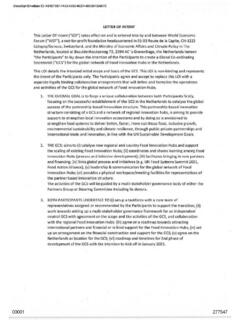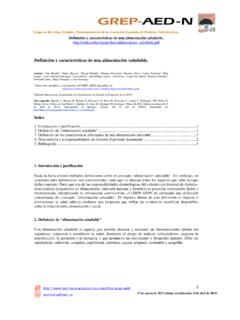Transcription of Who Guidelines on CD4 and VL for Art Doherty?
1 Excellent healthcare locally delivered WHO Guidelines on the use of CD4, Viral Load and EID tests for initiation and monitoring of ART Meg Doherty Treatment and Care Unit WHO, geneva Clinically relevant Earlier initiation of ART (CD4 count 500 cells/mm3) for adult s & adolescents Immediate ART for children below 5 years More potent regimens for children < 3 years (LPV/r) Immediate & lifelong ART for all pregnant and breastfeeding women (Option B/B+) Simplified, less toxic 1st-line regimens (TDF/XTC/EFV) Operationally relevant Use of Fixed Dose Combinations (FDCs) Improved patient monitoring with increased use of viral load Recommend task shifting, decentralization, and integration Community based testing and ARV delivery The 2013 Consolidated ARV Guidelines : Key recommendations 0102030405060708090100% CD4 500yes% < 5 yrs yes% OptionB/B+%TDF/XTC/EVFyes% Routine VLYes% SDC yesAFROAMROEMROEUROSEAROWPROM aking Impact in Countries 2013-14 ARV Policies (% responding yes, by region) Uptake of 2013 recommendations as of Oct 2014 Policy uptake in 58 WHO focus countries end 2014, by region Access to ART worldwide has significantly increased but coverage still very Hill et al.
2 CROI 2015 [abstr 1118] Even in settings with good testing & ART coverage, treatment cascades still show important Hill et al. CROI 2015 [abstr 1118] Major WHO Normative Documents on HIV Treatment, Care and Prevention (2013-2014) 2013 2013 Consolidated WHO ART Guidelines Screening, care and Treatment of Hepatitis C infection Guidance for HIV HTC & Care for Adolescents Use of devices for adult MC for HIV prevention 2014 Update Report on Health Sector Response to HIV December 2014 Guidelines Supplement Technical update on VL testing implementation Consolidated Guidelines for key populations 2014 2015 March 2014 Guidelines Supplement WHO, Feb 2015 Technical report on access to ARVs in LMIC 2013 Global Update on HIV Treatment Technical report on use and availability of HIV diagnostics 2013-2016 ARV forecast & drug price database Skin & Oral Manifestations in PLHIV QA for PoCT handbook Innovations in Diagnostics CD4 VL EID Treatment initiation still late in the large majority of countries Courtesy: D Cooper, IAC 2014 POC CD4 implementation across sub-Saharan Africa Ethiopia.
3 104 sites Kenya: 77 sites Uganda: 303 sites Tanzania: 445 sites Zambia: 68 sites Malawi: 126 sites Mozambique: 132 sites Zimbabwe: 276 sites Swaziland: 77 sites Lesotho: 42 sites 9 Weinberg et al, JIAS 2013 Impact of Point of care CD4 on linkage/retention in HIV care Odds of linking to care increased Time to testing reduced by 9 days Time from testing to receiving the result was reduced by 17 days CD4 changes when virally suppressed in S. Africa >90% of suppressed patients maintained CD4+ cell counts >200 cells/ l up to 10 years 97% (133/137) of CD4 declines <200 cells/ l were transient Ford et al 2015, Submitted Meta-analysis of 11 studies <1% of patients who were virologically suppressed experienced a CD4 decline Safe to scale down CD4 for monitoring when VL These data are consistent with findings from trial and observational studies in Western settings that CD4 measures rarely change in virologically suppressed patients CD4 remains a critical diagnostic tool for risk stratification and ART and prophylaxis decisions In settings where both CD4 and viral load are available, countries could consider reducing or eliminating CD4 for monitoring When should CD4 be used for initiation & monitoring?
4 CD4 for initiation: Point of care CD4: Increased access to testing in rural and remote areas Reduced turn around time for results Potential decrease in LTFU 2013 ARV Guidelines : CD4 monitoring every 6 months on ART 2014 Supplement: Changing role of CD4 HIV viral load when available is a more reliable tool for monitoring CD4 for screening for opportunistic infections 2015 - CD4 Guidelines new questions Does point of care CD4 count improve linkage to HIV care and timeliness of ART initiation? In individuals with HIV who have achieved viral suppression on ART is CD4 count and VL annually more effective than VL annually? RECOMMENDATION STRENGTH Viral load is recommended as the preferred monitoring approach to diagnose and confirm ARV treatment failure Strong recommendation, low-quality evidence If viral load is not routinely available, CD4 count and clinical monitoring should be used to diagnose treatment failure Strong recommendation, moderate-quality evidence WHO 2013 Recommendations: Monitoring for ART Response Plasma DBS 1000 cpm 1000 cpm Threshold for defining virological failure.
5 Pop Viral load Sensitivity Specificity PPV NPV Adults >5000 Adults 50-4,999 Adults >10,000 Children >5,000 Children >400 Immunological and clinical criteria Rutherford et al, IAS 2014 Immunological and clinical monitoring have poor sensitivity and lower positive predictive value for identifying virologic failure Targeted viral load monitoring (suspected clinical or immunological failure) Routine viral load monitoring (early detection of virological failure) Switch to second-line therapy Maintain first-line therapy Viral load 1000 copies/ml Viral load >1000 copies/ml Repeat viral load testing after 3 6 months Evaluate for adherence concerns Viral load >1000 copies/ml Test viral load Rationale: Viral Load Monitoring Viral load to reinforce adherence and confirm treatment failure Proportion resuppressing after adherence intervention Bonner et al, JAIDS 2013 Implementation considerations ART access should be the first priority: Lack of laboratory tests for monitoring treatment response should not be a barrier to initiating ART Prioritization: If viral load availability is limited, it should be phased in using a targeted approach to confirm treatment failure.
6 This may be particularly relevant in populations receiving ARVs to reduce HIV transmission, such as pregnant and breastfeeding women and in sero-discordant couples. Viral Load Implementation Guidance for MoH Phase in, planning, lab network Overview of technologies DBS use, cutoff at 1000cpm Quality Phase I: Planning Policies and Leadership Harmonization Algorithm Mapping and Forecasting Assess Capacity Costing Specimen and Product Selection Equipment Procurement Phase II: Scale Up Phase In Human Resources Training and Supervision Quality Management System Phase III: Sustainability Partner Harmonization M&E Data Collection Operational Research Viral load 1000 copies/ml Annual testing ART Initiation Switch to second-line therapy Maintain first-line therapy Viral load 1000 copies/ml Viral load >1000 copies/ml Repeat viral load testing after 3 6 months Adherence counselling Viral load >1000 copies/ml Test viral load 6 months Suggested Revisions Routine Why do we want to detect early poor adherence?
7 Patients who had a VL taken at month 3 versus at month 6 were 22% less likely to experience virological failure and 27% less likely to be switched to a second line regimen For each additional month of delay in taking the first viral load ( between and 9 months) the risk of virological failure increased by 9% and the risk of treatment switching increased by 14% IAS 2011 Specimen Type and Operational Considerations WHO Technical Update 2014 Table 1. Provisional data on performance characteristics for commercially available molecular HIV viral load assays using dried blood spot specimens compared with plasma at 1,000 copies/ml cut-off Guidance on use DBS for Viral Load The use of dried blood spots for viral load testing is recommended if logistical constraints challenge the use of plasma. Dried blood spots should be used with the same threshold of plasma for ART failure: 1,000 copies/ml.
8 Not all technologies should be used for viral load testing with dried blood spot samples. While the performance of dried blood spot samples is currently acceptable for most technologies, the lower acceptable limits for sensitivity and specificity are unclear. QA Cycle for Implementing POCT Plan Define Implement Monitor Evaluate Improve 27 PHASE III: Evaluate, Improve, and Sustain market surveillance monitoring data for decision making and communication of best practices social entrepreneurship and public private partnerships country ownership research Quality Assurance Cycle Ensuring accurate patient results PHASE I: Planning Quality Improvement for HIV-related POCT Leadership the national QA/POCT coordination team roles and responsibilities or review policies & incorporate QA into national plan standards for quality for POCT situational analysis and implement plan financial and human resources and assessment of sites of product PHASE II.
9 Implementation of Quality Assurance for POCT training and ensure certification of all POC Testers supervision and certification QA Process Control and innovate QA-related documentation supply chain for QA 2015 VL Update Questions In individuals receiving ART, is initial viral load testing at 3 months more effective than at 6 months? In individuals ART is dried blood spot testing at VL threshold> 1000 cpm as effective as VL> 1000 cpm using plasma? In individuals on ART, 20% misclassification of viral load result using dried blood spot (DBS) testing acceptable? (Modelling question) 29 Infant Testing Algorithm 4/10/2015 30 Better retention in the cascade Earlier ART initiation Low sensitivity of virological testing at birth Increased cost Birth PCR Testing at birth 4/10/2015 31 2015 EID Update Questions 1 Does birth testing improve retention and ARV initiation?
10 Can HIV exposure be confirmed using HIV rapid antibody tests (in HIV-exposed and -unexposed infants)? Can rapid HIV antibody tests be used to exclude HIV infection (in HIV-exposed and unexposed infants)? Can HIV infection in HIV-exposed and -unexposed children aged 18 months and older be diagnosed using HIV rapid antibody tests? 2015 ARV Guidelines Timeline September October November December January February March April May June July August September October November December January February Publication Process Updated Consolidated ARV Guidelines Launch Dec 2015 Systematic reviews Values and preferences Community consultations Modelling (Dec May, 2015) Supplement launch WAD Dec 1 2014 PADO 2 Dec 8-9 Core Group meeting Oct 20-21 2014 Civil society representation Civil society representation Community consultation Community consultation Values and preferences CSRG CSRG CSRG B+ Jan 14-16 PEER REVIEW Submission to GRC Sept 2014 Vancouver IAS July 19-22 Guideline Development Group Meetings: Clinical/operational Jun 1-5 2015 June 16-19 2015 Programmatic Update IAS July 2014 Programmatic Chapter Core Group July 23-24











